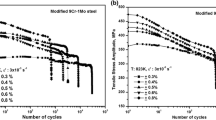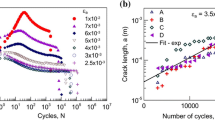Abstract
Cyclic-deformation behavior of low-carbon steel and copper under constant-stress amplitude and in a two-step stress change has been studied in the intermediate life range. Under constant-stress amplitude, there is initial softening followed by a hardening process in low-carbon steel. In the case of copper, hardening sets in from the initial stages of stress application. The total hysteresis energy absorbed is not a material constant, but depends on the applied stress. The strain-hardening/strain-softening behavior under the second stress level is different from the standard fatigue tests and is dependent on the first stress level. An energy-based analysis has been found to predict fairly well the cumulative damage life in low-cycle fatigue.
Similar content being viewed by others
References
Martin, D.E., “An Energy Criterion for Low Cycle Fatigue,”Trans. ASME, J. Basic Engrg., (83),565–571 (1961).
Feltner, C.E. andMorrow, J.D., “Microplastic Strain Hysteresis Energy as a Criterion for Fatigue Fracture,”Trans. ASME, J. Basic Engrg., (83),15–22 (1961).
Morrow, J.D., “Cyclic Plastic Strain Energy and Fatigue of Metals,” Internal Friction Damping and Cyclic Plasticity, ASTM STP 378 (1965).
Lukas, P. andKlesnil, M., “Cyclic Stress-Strain Response and Fatigue Life of Metals Low Amplitude Region,”Mat Sci. Engrg. (11),345–356 (1973).
Bui-Quoc, T., “Cyclic Stress, Strain and Energy Variations Under Cumulative Damage Tests in Low Cycle Fatigue,”J. Testing and Evaluation, JTEVA, (1),58–64 (1973).
Bui-Quoc, T., Dubuc, J., Bazergui, A. andBiron, A., “Cumulative Fatigue Damage Under Strain Controlled Conditions,”J. Mats., (6),718–737 (1971).
Dubuc, J., Bui-Quoc, T., Bazergui, A. and Biron, A., “Unified Theory of Cumuletive Damage in Metal Fatigue,” Weld. Res. Council Bull., (162) (1971).
Neuber, H., “Theory of Stress Concentration for Shear-Strained Prismatical Bodies with Arbitrary Non-linear Stress-Strain Law,”Trans. ASME, J. Appl. Mech., (28),544–550 (1961).
Author information
Authors and Affiliations
Rights and permissions
About this article
Cite this article
Radhakrishnan, V.M. Cumulative damage in low-cycle fatigue. Experimental Mechanics 18, 292–296 (1978). https://doi.org/10.1007/BF02324159
Received:
Revised:
Issue Date:
DOI: https://doi.org/10.1007/BF02324159




